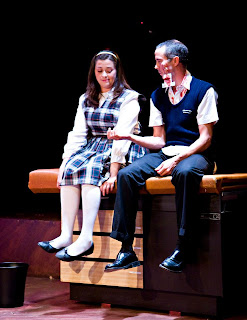Whatever its deeper meanings, Folger Theatre’s The Conference of the Birds, in a stage version by Peter Brook and Jean-Claude Carriere and directed by Aaron Posner, is a downright brilliant piece of theater. The key words are intricacy and precision.The main elements: Erika Chong Shuch’s choreography for the ensemble cast, involving a significant degree of coordinated group movement, unison breathing, hand gestures, and occasional bits of tumbling; Jennifer Schriever’s spectacularly detailed and varied lighting design; Tom Teasley’s music on multiple instruments. Each movement by the ensemble is perfectly, instantaneously timed with corresponding light cues and individual notes in Teasley’s music. The evening is one of virtuosic execution of a carefully conceived plan for presenting the story.
The story, based on a 12th century Sufi poem written by Farid Uddi Attar, is a mythic quest, deep in Joseph Campbell territory. Led by the Hoopoe (Patty Gallagher), the 10-strong ensemble, representing all the other birds, debate how to deal with their uncertainties and dissatisfactions by seeking their true king, Simorgh. The “conference” of the title takes place in the first act. The Hoopoe tries to persuade the other birds to begin the quest. Many of the other birds demur. The Parrot (Robert Barry Fleming) is comfortable in his cage; the Duck (Katie deBuys) is reluctant to leave the comfortable water in her pond; the Falcon (Jay Dunn) wishes to remain with his king; the Sparrow (Britt Duff) is too timid to take a dangerous journey, etc. The Hoopoe responds primarily by telling stories. To the Falcon, for example, she recounts a series of stories in which kings arbitrarily kill their devotees. Ultimately the Hoopoe – the narrator as well as the leader of the flock – succeeds in persuading the others to leave their fears and comforts behind and undertake the journey.
As befits a mythic quest, the journey is long and arduous, involving a wide desert and seven valleys (representing various emotional and existential states — quest, love, unity, astonishment, etc.) through which the birds must pass, each with its own challenges and its own meanings to decipher. Many fall short: the 30 that succeed learn that Simorgh is not a separate being (no Wizard at the end of these birds’ Yellow Brick Road), but within themselves (indeed, “Simorgh” is a Persian pun for “30 birds”). As one commentator put it, “By annihilating themselves gloriously in the [Simorgh] they find themselves in joy, learn the secrets, and receive immortality. So long as you do not realize your nothingness and do not renounce your self-pride, vanity, and self-love, you will not reach the heights of immortality. Attar concluded the epilog with the admonition that if you wish to find the ocean of your soul, then die to all your old life and then keep silent.”
In keeping with the superb stagecraft of the production, the burlap curtains that are a key part of Meghan Rahm’s set design part at the play’s conclusion to reveal a mirror in which the birds see themselves. Given the allegorical nature of the work – these are human emotions and a human spiritual quest we are dealing with, after all — Olivera Gajic’s costume design makes no attempt to make the cast look like birds. The subdued palate emphasizing greys, browns, and greens never calls attention to itself (save one disco queen-like costume for a peacock) and perfectly complements the movement and lighting of the production.
The members of the ensemble cast do it all – moves, speaks clearly and in character, sings on some occasions – and most of all do it in perfect harmony with one another.Regardless of how much Sufi mysticism of a millennium ago may or may not resonate with a Washington audience of today, the presentation of Attar’s story at the Folger can only inspire admiration.











